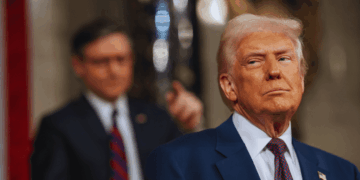By Lawrence L. Herman, March 12, 2024
Introduction: A Trade War Looms
Looking at the trade picture in today’s fractured world, it’s the war between the West and China over exports of Chinese electric vehicles (EVs) that is set to dominate the agenda. The clash will be over the export not just of assembled vehicles, but a wide swath of automotive parts, components, and strategic minerals used in their production. The implications of the conflict stretch deep into national decarbonization policies and supply chains.
Canada’s auto parts industry has already voiced concerns “about a string of investments by Chinese firms in Mexico’s auto industry, moves it argues are designed to skirt rules in the United States-Mexico-Canada Agreement that give favourable tariff treatment to cars made mostly with North American parts” (Chase 2023).
What do these and other concerns mean for Canada, not only for the automotive sphere but for Canadian trade policy writ large? The following explains the issues and offers some suggestions for action.
It’s complicated
The trade picture is complicated by the fact that 2024 is an election year in the United States and Mexico, with Canada not too far behind. These past weeks attention has focused on the US primaries. It’s fair to predict that, regardless of November’s election result, Chinese EV exports and the slew of related supply chain concerns will be a major trade policy issue in Washington.
It will be in Ottawa as well, as large volumes of Chinese vehicles and related equipment are poised to enter the Canadian market, affecting the automotive and decarbonization sectors alike. The federal government will face the continual challenge of implementing adequate trade and fiscal responses.
The China challenge
A report by the European Council on Foreign Relations last December issued an ominous warning, saying that, “While China’s early industrial policy may have been a global public good by allowing the commercialisation of a nascent clean technology, Beijing is now expanding its dominance. Its economic policy will produce overcapacities that could strangle the healthy global competition for the best EV technologies, business plans, and local value distribution and destroy markets elsewhere, burying any semblance of de-risking with it” (Gehrke and Medunic 2023).
The Economist published a feature on China’s growing share of the global EV market on January 11, 2024, reporting that China has massively subsidized this sector and “brazenly disregarded global trading rules.” It also referred to China’s “ransacking” of Western carmakers’ technology.
On February 27, 2024, the New York Times published a report on Chinese automakers being the biggest threat to North American producers, saying “China’s electric vehicles are going to hit Detroit ‘like a wrecking ball.’”
Even so, The Economist also says there are benefits to having access to well-made, cheaper, and environmentally friendly vehicles. It urges Western policymakers to curb their protectionist instincts, concluding that “a hefty market share for Chinese carmakers that invigorates wider competition, however, is not to be feared. If China wants to spend taxpayers’ money subsidising global consumers and speeding up the energy transition, the best response is to welcome it” (The Economist 2024).
The EU takes action
That view may not have resonated with policymakers in the West, however. The fight with China was already brewing last fall when the Globe and Mail’s Eric Reguly wrote about the impending European Union trade action against cheap, subsidized Chinese exports flooding the European market (Reguly 2023).
That action was started in early October, in what can be described as a fairly standard procedure under World Trade Organization (WTO) rules, when the EU began a self-initiated investigation leading to the potential of countervailing duties on the offending imports. The European Commission stated that:
The investigation will first determine whether BEV [battery electric vehicle] value chains in China benefit from illegal subsidisation and whether this subsidisation causes or threatens to cause economic injury to EU BEV producers…. Based on the investigation’s findings, the Commission will establish whether it is in the EU’s interest to remedy the effects of the unfair trade practices found by imposing anti-subsidy duties on imports of battery electric vehicles from China…
The Commission launched this investigation on its own initiative (ex officio), having gathered sufficient evidence that the recent surge in low-priced and subsidised imports of electric vehicles from China into the EU posed an economic threat to the EU’s electrical car industry…. (EU 2023)
The EU action is an orthodox trade remedy route under WTO rules, combatting subsidized imports by launching a countervailing duty investigation. If Chinese subsidies are confirmed – which seems almost certain – the EU will initiate a further phase to determine if those imported vehicles, batteries and parts are the direct cause of “material” injury to EU vehicle manufacturers. If the EU can establish this causal link, WTO rules allow countervailing duties to be applied up to the amount of the subsidy. The idea is to level the playing field.
Global ramifications
The EU case has wide implications. As Bloomberg reported, “the investigation has the potential to reshape the competitive dynamics within Europe, the second-largest EV market after China, and raises the risk that its own carmakers could face potential retaliation and countervailing measures” (Eckl-Dorna 2023).
Another Bloomberg report (updated on January 2, 2024) says that while it is widely accepted that EVs are the future of the auto industry, “it’s only in the past year that it’s become clear how big a lead Chinese automakers have opened in the field. Chinese-made cars now not only dominate their home market, the world’s largest, but are being exported in growing numbers. In addition to the lower cost and advanced technology of made-in-China cars, the country has also come to dominate the EV supply chain in ways that will make it difficult for manufacturers elsewhere to close the gap. Analysts have warned that Western automakers could lose a quarter of their market share because of the rise of cheaper Chinese EVs” (Nicola and Lew 2024).
Leading expert Gary Hufbauer recently observed, “if other countries had no auto industries and if China did not pose a military threat, everyone would welcome cheap Chinese EVs. But in the world as we know it, Chinese EVs are more of a burden than a blessing. This is because large-scale exports put millions of jobs at risk and other countries fear China hovering over the geopolitical landscape” (Hufbauer 2023).
The EU investigation has a long way to run, but it is indicative of the assertion that Chinese imports are “terrifying” Western countries, as The Economist put it, and that governments are showing a willingness to consider a variety of trade remedies to level the playing field, including taking national security measures deemed in the public interest that go beyond the automotive sector where other exports also benefit from massive Chinese subsidies.
American responses
Here in North America, the “competitive dynamics” affecting Chinese EVs will be determined by the actions of the United States. One phase that is going full steam ahead is under the Biden administration’s Inflation Reduction Act, which is aimed at bringing American production back to the United States by providing tax credits for EVs built in North America and with components sourced in North America or from countries with whom the US has free trade agreements. Imported Chinese vehicles, batteries and other key automotive parts sourced from China will not qualify for those subsidies.
In addition to the IRA tax credits, the Trump administration imposed tariffs on Chinese vehicles in 2018 under the famous section 301 of the US Trade Act of 1974, allowing the executive (i.e., the US trade representative) to take direct action in response to foreign practices claimed to violate US trade agreements or engage in acts that are “unjustifiable” or “unreasonable” and burden US commerce.[1] President Donald Trump used the law to impose 27.5 percent tariffs on a wide range of Chinese goods, including electric vehicles. Even though China responded with its own increased tariffs on US goods, the US section 301 duties, subject to some carefully drawn exclusions, remain in place today.[2]
Several WTO panels have said that because these WTO tariffs do not follow WTO procedures, they are contrary to the agreement (US Congressional Research Service 2020, 2226). However, with the WTO’s own adjudicative system paralyzed, no final determination has been made on the matter, meaning nothing at the WTO will deflect the US from using section 301 as one of its economic tools in the war against subsidized Chinese vehicle imports.
The Biden administration is reviewing these section 301 tariffs. With pressure from business, the New York Times recently reported that “administration officials appear likely to raise tariffs on electric vehicles and other strategic goods from China, as part of a review of levies that former President Donald J. Trump imposed on China four years ago” (Swanson and Tankersley 2024). According to the same New York Times report, as a result of such pressure the Biden administration says it will work with US companies “to identify and deploy additional responses to help overcome China’s state-directed industrial targeting in this sector.”
Canadian options
There is a series of disconnects between Canadian measures and those south of the border. This is a problem, especially with the rapid growth of Chinese EV imports into Canada, the value of which was approximately $2.0 billion in 2023. With integrated Canada-US automotive production, divergent trade and industrial policies, including greater ease of entry of Chinese vehicles and parts here, will further strain the bilateral relationship.
This paper is not the place to discuss these shortcomings in detail, but below is a summary of where the Canadian government needs to consider action to better coordinate with the Americans.
Tax credits: In the US under the IRA, tax credits aren’t available for purchases of Chinese-made vehicles or for vehicles carrying a given percentage of Chinese-made battery or critical mineral components. In contrast, Canada’s EV tax credits (up to $5,000 per vehicle) contain no such restriction or condition. Canadian manufacturers have voiced this as a major concern. The disconnect with the American tax credit system needs addressing.
Duty rates: As noted, the US tariff on Chinese EVs has been increased to 27.5 percent. Canada’s rate remains at the most-favoured-nation (MFN) rate of 6.1 percent. The federal government could change this to match the US rate but so far has not done so.[3]
Import surcharges: The Trump administration applied tariff surcharges on high-tech goods from China under the national security provisions of the Trade Expansion Act. Canada has no similar national security law. The closest law is the Customs Tariff, already noted, which allows cabinet orders imposing import surcharges but omits reference to surcharges on the basis of national security.
Import controls: Likewise, in the case of import controls under Canada’s Export and Import Permits Act, there is no reference to national security as a factor for including products from particular countries on Canada’s Import Control List.[4]
Conclusion – Coordination needed
To address the disconnects between Canadian measures and those in the US intended to stem the Chinese tide of subsidized goods in the automotive sector, the federal government needs to act. Coordinating response efforts with the US is essential in light of the tightly integrated automotive sector – and in light of Canada’s ongoing efforts to work jointly with the US on critical minerals. The disparities need to be urgently addressed.
Together with tax credits on the fiscal side, the most obvious areas needing attention are in tariff surcharges and in filling shortcomings in laws regarding national security as a basis for import action. It is not adequate for Canada to be left with only WTO-type countervailing duty remedies as its sole response tool for dealing with Chinese EVs.
LAWRENCE L. HERMAN, Cassidy Levy Kent LLP (Ottawa & Washington) and Herman & Associates (Toronto), has practiced international trade and investment law and policy in government and in the private sector for over 50 years.
Lawrence Herman was a member of Canada’s mission to the UN and the GATT in the 1970s, and in private law practice, acted as counsel for Canada in the International Court of Justice and has advocated cases before the Canadian International Trade Tribunal (CITT), NAFTA panels, and Canadian courts. Herman advises governments, state agencies, and international organizations on trade, economic sanctions, and investment issues.
He is a Senior Fellow of the C. D. Howe Institute, a Fellow of the Canadian Global Affairs Institute, a member of the North American Forum and the Executive Committee of the Canada-US Law Institute, and past chair of the Canadian International Trade Tribunal’s National Advisory Committee.
Among his other affiliations, Herman has been chair of the Canada-Taiwan Business Association, and a board member of the Canadian Institute of International Affairs, the Canadian Manufacturers Association, the Energy Council of Canada and the Council for Business and the Arts. In recent years, he served as vice-chair of Jazz FM.91, a public radio station, and chair of the Toronto Summer Music Festival.
He has authored and edited two compendium volumes on international trade: Canadian Trade Law: Practice and Procedure (Thomson Reuters 2007, 2016) and Export Controls & Economic Sanctions (Thomson Reuters 2010). Herman regularly publishes commentaries on international law and policy for think-tanks and for various news publications.
References
Chase, Steven. 2023. “Canadian Auto Parts Industry Sounds Alarm over Chinese Investments in Mexico.” Globe and Mail (November 6). Available at https://www.theglobeandmail.com/business/article-canadian-auto-parts-industry-sounds-alarm-over-chinese-investments-in/.
Eckl-Dorna, Wilfried. 2023. “BMW’s Chinese EV Exports Are Target of EU Anti-Subsidy Probe.” BNN Bloomberg (October 6). Available at https://www.bnnbloomberg.ca/bmw-s-chinese-ev-exports-are-target-of-eu-anti-subsidy-probe-1.1981270.
European Union [EU]. 2023. “Commission Launches Investigation on Subsidised Electric Cars from China.” Press Release (October 4). Available at https://ec.europa.eu/commission/presscorner/detail/en/ip_23_4752.
Gehrke, Tobias, and Filip Medunic. 2023. “High-voltage Trade: How Europe Should Fight the Electric Vehicle Wars.” European Council on Foreign Relations (December 15). Available at https://ecfr.eu/article/high-voltage-trade-how-europe-should-fight-the-electric-vehicle-wars/.
Hufbauer, Gary. 2023. “China’s Electric Vehicle Surge Will Shock Global Markets.” East Asia Forum (November 21). Available at https://eastasiaforum.org/2023/11/21/chinas-electric-vehicle-surge-will-shock-global-markets/.
Nicola, Stefan, and Linda Lew. 2024. “How China’s Car Companies Built So Wide a Lead in the Race to Make EVs.” Bloomberg (January 2). Available at https://www.bloomberg.com/news/articles/2023-11-01/how-china-carmakers-came-to-dominate-the-ev-industry-quicktake.
Reguly, Eric. 2023. “The EU and China Are on the Verge of a Retaliatory Trade War over EVs. China Has the Upper Hand.” Globe and Mail (September 22). Available at https://www.theglobeandmail.com/business/commentary/article-the-eu-and-china-are-on-the-verge-of-a-retaliatory-trade-war-over-evs/.
Swanson, Ana, and Jim Tankersley. 2024. “Flush with Investment, New U.S. Factories Face a Familiar Challenge.” New York Times (January 15). Available at https://www.nytimes.com/2024/01/15/business/economy/china-electric-cars-chips-solar.html.
The Economist. 2024. “An Influx of Chinese Cars is Terrifying the West.” The Economist (January 11). Available at https://www.economist.com/leaders/2024/01/11/an-influx-of-chinese-cars-is-terrifying-the-west.
US Congressional Research Service. 2019. Enforcing U.S. Trade Laws: Section 301 and China. US Congressional Research Service. Available at https://crsreports.congress.gov/product/pdf/IF/IF10708.
US Congressional Research Service. 2020. Section 310 of the Trade Act of 1974: Origin, Evolution and Use. US Congressional Research Service (December 14). Available at 2020, at pp. 2226. Available at https://crsreports.congress.gov/product/pdf/R/R46604.
US Congressional Research Service. 2024. Section 301 of the Trade Act of 1974. US Congressional Research Service (January 29). Available at https://crsreports.congress.gov/product/pdf/IF/IF11346.
Notes:
[1] A very good explanation of the workings of section 301 can be found in a US Congressional Research Service report from January 29 of this year: Section 301 of the Trade Act of 1974. This report updates a 2019 CRS report entitled Enforcing U.S. Trade Laws: Section 301 and China.
[2] Trump also used another provision, section 232 of the 1962 Trade Expansion Act, to impose tariff surcharges of 25 percent and 10 percent on imports of steel and aluminum from most US trading partners, including China. Canada and the US agreed to remove the duties on Canadian imports.
[3] Section 53 of Canada’s Customs Tariff permits orders-in-council (i.e., cabinet orders) to apply tariff surcharges for purposes of “enforcing Canada’s rights under a trade agreement in relation to a country or of responding to acts, policies or practices of the government of a country that adversely affect, or lead directly or indirectly to adverse effects on, trade in goods or services of Canada.”
[4] For example, goods may be listed by cabinet order to restrict imports of arms and ammunition or certain agricultural goods and to implement various intergovernmental agreements. None of these criteria would allow Chinese vehicles to be listed.








